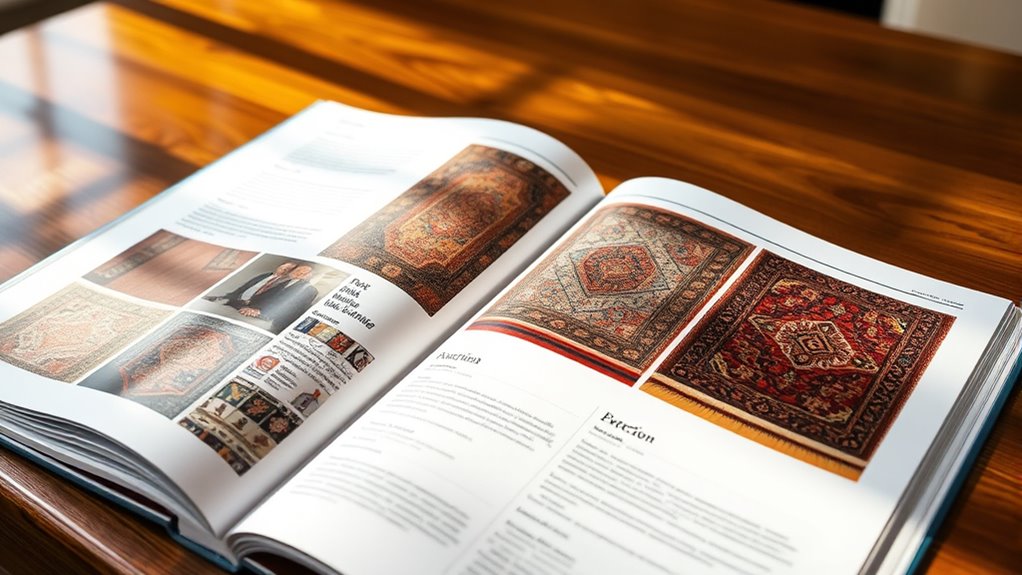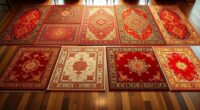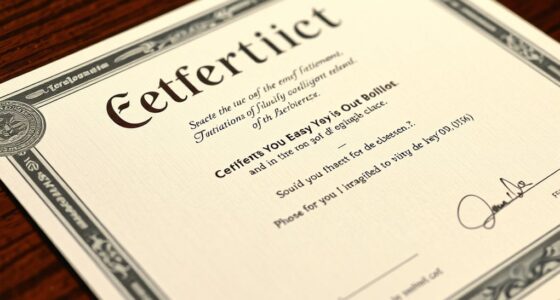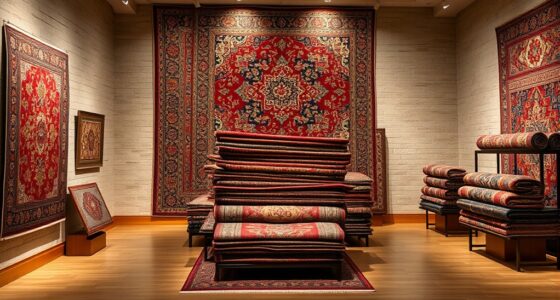To understand a rug auction catalogue, start by examining its organized descriptions detailing the origin, age, size, and estimated value of each rug. Pay attention to key features like knot density, weaving techniques, materials, and dye types to assess quality and authenticity. Look closely at photographs for condition details, repairs, and color vibrancy. Familiarize yourself with auction terms and pricing ranges to bid confidently. Continuing will help you gain deeper insights into evaluating and selecting rugs effectively.
Key Takeaways
- Review lot descriptions carefully, focusing on origin, age, size, and materials like wool or silk.
- Examine photographs and diagrams for details on weaving techniques, knot density, and condition.
- Understand terminology such as knots per inch, dye types, and abbreviations to assess quality and authenticity.
- Check provenance, ownership records, and certificates to verify authenticity and historical background.
- Consider estimate ranges and market trends to develop informed bidding strategies and valuation insights.
Understanding the Structure of the Catalogue
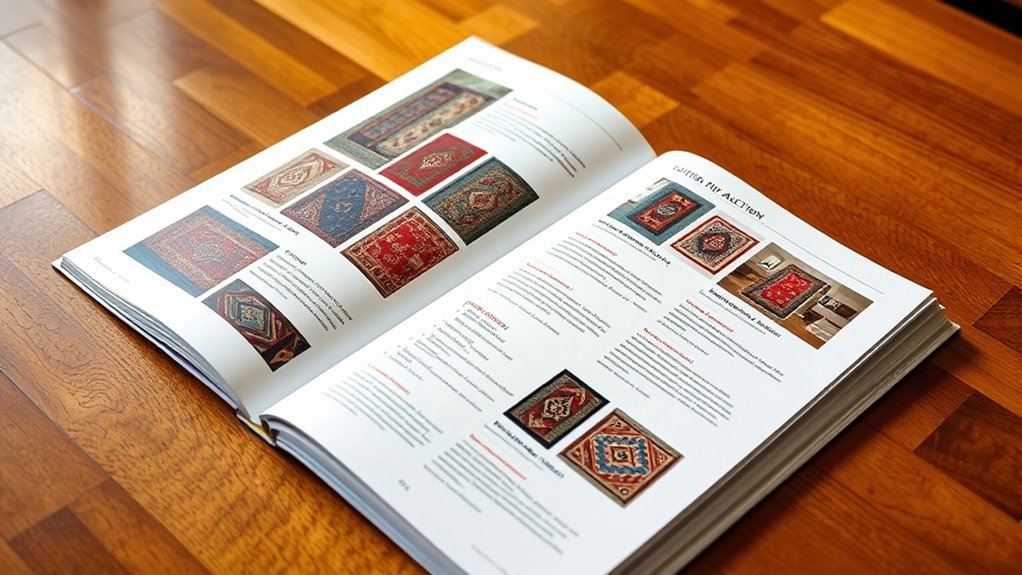
To understand a rug auction catalogue effectively, you need to familiarize yourself with its basic structure. The catalogue typically presents entries in a consistent format, making it easier to compare items. You’ll see key details such as the rug’s origin, age, size, and estimated value. Pay close attention to the description of weaving techniques, as these influence a rug’s quality and value. Knots per inch is another essential detail; a higher knot count usually indicates finer craftsmanship. The catalogue often includes photographs and sometimes diagrams to illustrate specific features. Recognizing how these elements are organized helps you quickly assess each rug’s characteristics and significance. Additionally, understanding the affiliate disclosures associated with the catalogue can provide insight into potential biases or marketing influences. By understanding the structure, you’ll be better equipped to interpret listings and make informed bidding decisions.
Deciphering Item Descriptions and Terminology
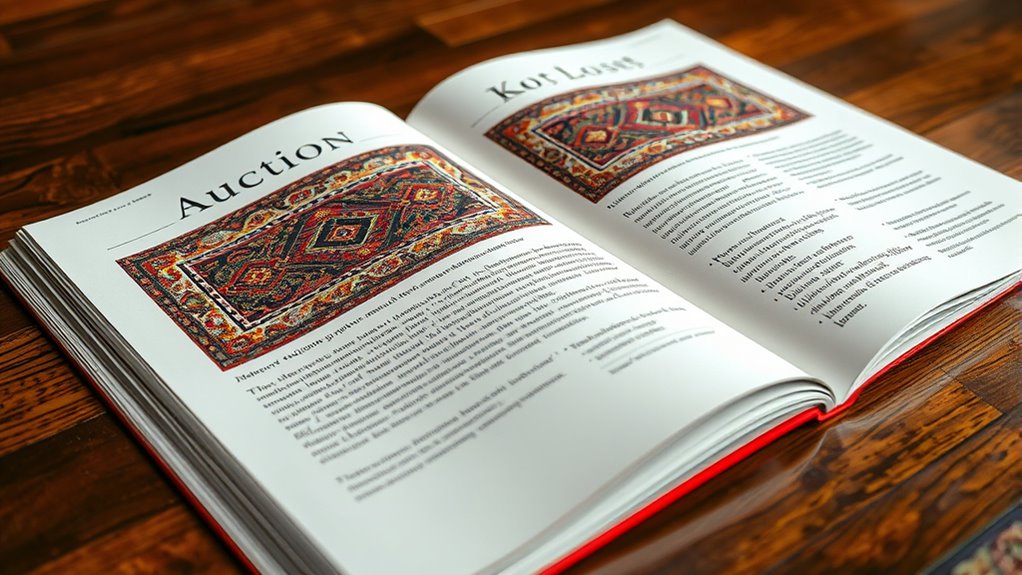
Once you’ve become familiar with the catalogue’s layout, the next step is to interpret the descriptions and terminology used for each rug. Pay attention to details like knots per inch, which indicate the rug’s craftsmanship and quality; higher knots usually mean finer, more detailed weaving. Look for mentions of dye techniques, such as plant or synthetic dyes, which can reveal the rug’s age and authenticity. Descriptions may specify wool, silk, or cotton piles, and whether the rug features symmetrical or asymmetrical knots. Understanding these terms helps you assess the rug’s value and origin. Be aware of abbreviations and shorthand used in the catalogue—these often condense important details about construction, materials, and style. Mastering this terminology makes you a more confident and informed bidder. Additionally, recognizing high-quality materials can significantly impact your appraisal of a rug’s durability and desirability.
Recognizing the Key Attributes of Rugs

Understanding the key attributes of rugs allows you to evaluate their quality and provenance quickly. One essential attribute is knot density, which measures the number of knots per square inch. Higher knot density generally indicates finer craftsmanship and durability. Examine the rug’s weave to assess this; a tightly woven rug with a high knot count is usually more valuable. Another critical factor is dye composition. Natural dyes, made from plants, insects, or minerals, tend to age gracefully, developing a rich patina over time. Synthetic dyes, meanwhile, often appear more uniform but may fade faster. Recognizing these attributes helps you distinguish well-made rugs from lesser-quality pieces and provides insight into their origin, age, and value. Additionally, analyzing the weaving techniques used can reveal the cultural and historical context of the rug, further aiding in authentication and valuation.
Interpreting Pricing and Estimate Ranges
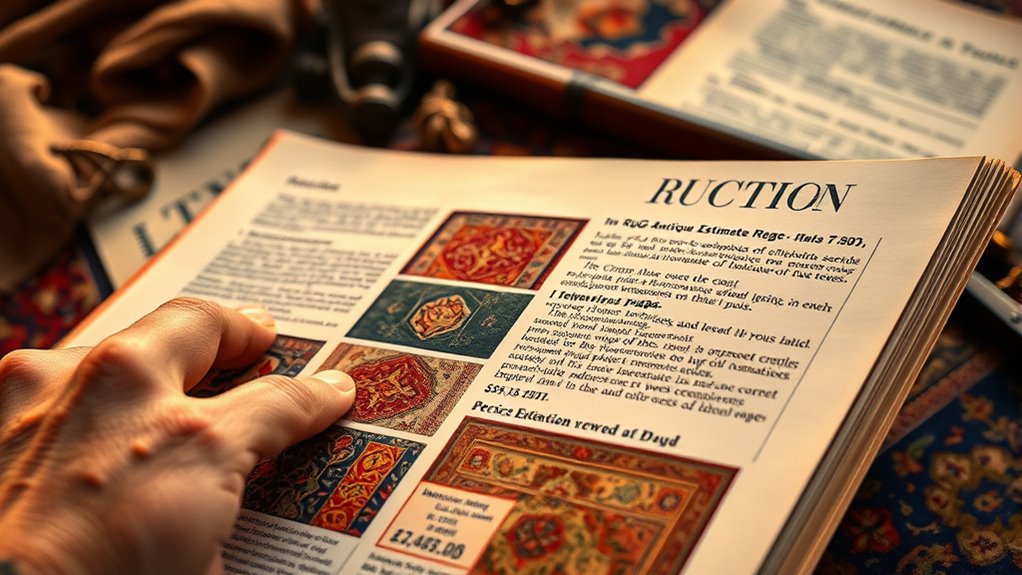
Understanding the estimate labels helps you gauge a rug’s value and potential price range. Analyzing price variations across lots reveals market trends and buyer interest. Recognizing these patterns enables you to make smarter bidding decisions and manage expectations effectively. Incorporating space optimization strategies can also help you better organize your collection and storage of rugs after purchase.
Understanding Estimate Labels
Estimate labels on rug auction catalogues provide essential guidance for buyers by showing the expected price range for each item. These estimate labels, often called valuation tags, give you a snapshot of what the auction house anticipates the rug may sell for. The labels typically include a low estimate and a high estimate, helping you gauge the potential value and set your bidding limits. It’s important to understand that these estimates are based on current market trends, rug condition, and provenance. They’re not fixed prices but serve as a reference point to determine if a rug’s potential value aligns with your budget. Paying attention to these estimate labels helps you make informed decisions and avoid overbidding on items outside your price range. Familiarity with market trends can further aid in interpreting these estimates accurately.
Analyzing Price Variations
Have you ever wondered how to gauge a rug’s true value from its price range? To do so, look closely at the estimate variations. Narrow ranges often indicate consistency in quality, while wider ranges suggest uncertainty or varying textile craftsmanship. Pay attention to the color palette, as rare or vibrant colors can increase value. Also, consider how the estimate aligns with the rug’s age and provenance. When analyzing price fluctuations, keep in mind:
- Consistent estimates may reflect stable demand or a well-understood market.
- Sudden jumps could indicate rarity or a recent surge in interest.
- Wider ranges might signal differing opinions on textile craftsmanship or condition.
- Understanding the factors influencing Gold IRA investments can provide insights into market trends and valuation stability.
Understanding these factors helps you interpret the pricing and estimate ranges more effectively, giving you insight into the true worth of the rug.
Recognizing Market Trends
Market trends can be revealed by how pricing and estimate ranges change over time. When you observe consistent shifts, it indicates evolving tastes or demand. For example, a rising estimate for rugs featuring intricate decorative motifs suggests increased collector interest, while a narrowing price range may signal market saturation. Pay attention to color palettes, as popular hues can influence pricing trends; vibrant, modern palettes often command higher estimates, reflecting current preferences. Conversely, traditional or muted color schemes might see steadier or declining ranges. Recognizing these patterns helps you gauge the market’s direction. By tracking how estimates fluctuate with styles like decorative motifs and color palettes, you gain insight into which rug types are gaining or losing popularity, enabling smarter buying decisions aligned with current market trends. Wave and wind interactions in coastal environments can also influence the durability and appearance of outdoor textiles used in beachside settings.
Analyzing Photographs and Visual Details
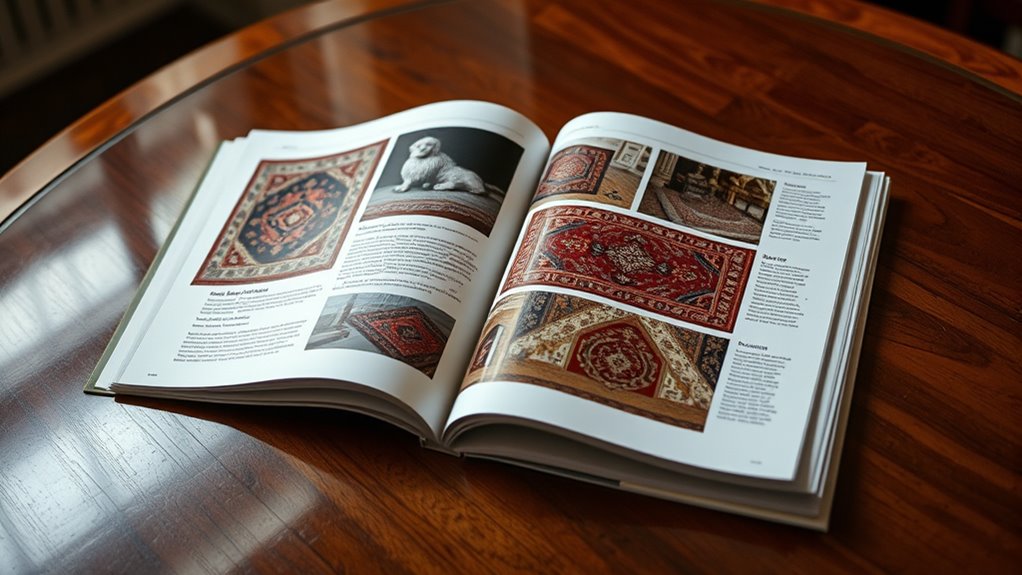
When examining photographs and visual details in a rug auction catalogue, it’s essential to focus on what the images reveal about the rug’s condition, design, and craftsmanship. Look closely at the color palettes to identify vibrancy, fading, or uneven dyeing, which can affect value. Pay attention to fabric textures, noting areas of wear, thinning, or repairs that might not be obvious in person. Consider the clarity and lighting of the photographs—sharp images help you assess details more accurately. Focus on these aspects:
- The richness or dullness of colors and how they may have aged
- Texture variations indicating wear, repairs, or fabric deterioration
- Fine design details and symmetry, revealing craftsmanship quality
These visual cues guide your understanding of the rug’s overall condition and authenticity.
Familiarizing Yourself With Provenance and History

Understanding a rug’s provenance helps you verify its authenticity and value. You should trace its auction origins and examine ownership records to uncover its history. By doing so, you gain insight into its past and the story it carries. Additionally, considering the website’s privacy policies can inform you about how personal data related to provenance research may be used or protected.
Trace Auction Origins
Tracing the origins of an auctioned rug involves carefully examining its provenance and historical record. To do this effectively, look for details that reveal its background, such as weaving techniques and dye analysis. These clues help verify authenticity and age. For example, identifying specific weaving styles can link a rug to a particular region or time period. Dye analysis can uncover the natural or synthetic dyes used, offering insights into trade routes and technological advances. To deepen your understanding, consider:
- Comparing weaving techniques with known regional styles
- Analyzing dyes to determine age and origin
- Checking for documentation or previous ownership records
- Recognizing Pinball Machine Weight variations can also assist in dating and authenticating certain rugs, especially those with machine-made features.
Examine Ownership Records
Examining ownership records provides valuable insights into a rug’s provenance and history. By reviewing documentation, you can verify ownership and guarantee authenticity through ownership verification. Provenance tracking helps confirm a rug’s origin and previous owners, reducing the risk of buying a forgery. Look for certificates, auction records, and sales history to piece together its ownership timeline. Understanding this history enhances your confidence in the rug’s value. Additionally, vetted sources ensure the reliability of the ownership information you gather.
Understand Historical Context
To truly appreciate a rug’s value, you need to familiarize yourself with its provenance and history. Understanding its background reveals its cultural significance and regional differences, which influence design and craftsmanship. Research where and when the rug was made, noting any historical events that shaped its style. This context helps distinguish authentic pieces from reproductions. Keep in mind:
- Provenance links the rug to specific cultures and traditions.
- Regional differences affect motifs, colors, and weaving techniques.
- Historical periods influence design elements and materials used.
Identifying Authenticity and Condition Reports

When evaluating a rug auction catalogue, understanding how to identify authenticity and interpret condition reports is essential. Check for details on knots per inch, which indicate craftsmanship and quality, and note dye techniques, revealing age and origin. Authentic rugs often have consistent knots per inch throughout, while condition reports highlight repairs, fading, or restorations. Be wary of rugs with irregularities or overly perfect condition, as these may be fakes. Use this table to compare key features:
| Authenticity Indicators | Condition Clues |
|---|---|
| Consistent knots per inch | Repairs or patches |
| Genuine dye techniques | Fading, stains, or wear |
| Provenance documentation | Structural damage |
| Age-appropriate wear | Color inconsistencies |
Understanding these factors helps you assess a rug’s value and authenticity confidently.
Comparing Lots and Making Selection Criteria

When comparing lots, focus on how clearly the descriptions outline the rug’s details and condition. Prioritize quality factors like craftsmanship, age, and rarity that add value to your selection. This approach helps you make informed decisions and find the best pieces for your collection.
Assessing Lot Descriptions
How can you effectively compare lots and establish your selection criteria from their descriptions? Focus on key details that highlight fiber types and weaving techniques, as these impact quality and value. Look for specific mentions like silk, wool, or cotton to understand fiber quality. Examine descriptions of weaving techniques such as knot density, symmetrical patterns, or hand-knotted craftsmanship. This helps you assess durability and artistry. To make informed choices, consider:
- Clarity and detail in describing fiber types and weaving techniques
- Consistency in terminology and terminology used by the auction house
- Notes on condition or repairs that could affect authenticity or value
Prioritizing Quality Factors
To effectively compare lots and establish your selection criteria, focus on identifying the key quality factors that influence value and longevity. Prioritize weaving patterns, as intricate designs often indicate craftsmanship, and evaluate dye techniques—natural dyes usually suggest higher quality and age. Consider the rug’s overall condition, including knot density and wear, which impact durability. Use this table to guide your decisions:
| Factor | What to Look For | Why It Matters |
|---|---|---|
| Weaving Patterns | Symmetry and complexity | Reflects skill and cultural authenticity |
| Dye Techniques | Natural vs. synthetic dyes | Affects age, vibrancy, and value |
| Knot Density | Number of knots per square inch | Indicates craftsmanship and durability |
| Condition | Repairs, wear, and fading | Determines longevity and worth |
| Provenance | Documentation and origin | Adds historical and monetary value |
Noting Bidding and Auction Terms

Understanding bidding and auction terms is essential to traversing a rug auction confidently. When reviewing the catalogue, pay attention to key phrases and symbols. For example, the lot number helps you identify specific rugs quickly. The bid increment indicates how much your bid must increase each time you raise it. Other important terms include *reserve price* (minimum bid accepted), *hammer price* (final bid), and *buyer’s premium* (additional fee). To stay sharp:
- Note the lot number for each piece you’re interested in.
- Recognize how bid increments affect your bidding strategy.
- Understand auction terms like reserve and hammer price to avoid surprises.
Being familiar with these terms guarantees you can follow the bidding process smoothly and make informed decisions during the auction.
Preparing for Bidding and Finalizing Your Choice

Before the auction begins, take time to thoroughly review the catalog and decide which rugs you’re genuinely interested in purchasing. Consider different appraisal methods to verify the rug’s value and authenticity. Research recent sales and expert opinions to set realistic bidding limits. Finalize your choice by inspecting detailed descriptions, photos, and condition reports. Think about shipping logistics in advance—know the costs and arrangements for transporting your purchase securely. Prepare your bidding strategy, including maximum bids and timing cues, to avoid impulsive decisions. Keep your budget in mind, and stay disciplined. Being well-prepared *guarantees* you’re confident when bidding, reduces surprises, and helps you make informed decisions that align with your goals and budget.
Frequently Asked Questions
How Can I Estimate a Rug’S Market Value Accurately?
To estimate a rug’s market value accurately, start by conducting a rug appraisal, considering factors like age, condition, and origin. Stay informed about current market trends, which influence prices. Compare similar rugs at recent auctions or sales to gauge value. Keep an eye on stylistic or material differences that affect desirability. This approach helps you make a well-informed, realistic estimate of your rug’s worth.
What Are Common Signs of Rug Restoration or Repair?
Spotting rug restoration is like finding a hidden puzzle piece. Look for dye inconsistencies, where colors don’t match perfectly, or uneven knotting, which can signal repairs. These signs often stand out against the original craftsmanship, revealing where repairs have been made. By carefully examining these details, you can better assess a rug’s true condition and authenticity, helping you make smarter buying decisions at auction.
How Do I Determine a Rug’S Age Beyond Listed Dates?
To determine a rug’s age beyond listed dates, you should examine the fiber analysis and dye identification. Fiber analysis reveals the materials used, which can indicate specific time periods, while dye identification helps spot natural versus synthetic dyes, often linked to certain eras. Look closely at the weave, knot density, and color fading, as these details, combined with your analysis, help you estimate the rug’s true age more accurately.
What Should I Look for in Auction House Reputation?
Like a lighthouse guiding ships, a reputable auction house shines brightly through its credibility. You should look for auction house credibility by researching their reputation thoroughly. Check online reviews, ask for references, and see if they’re members of professional associations. A strong reputation is built on transparency, fair dealings, and consistent success. Trustworthy auction houses make your buying experience smoother, ensuring you’re dealing with seasoned experts rather than unreliable newcomers.
How Do I Set a Realistic Bidding Budget?
When setting a realistic bidding budget, you should start with clear budget planning and consider your limits. Use bidding strategies that prioritize your maximum bid, avoiding emotional bidding. Research the rug’s value beforehand, and stick to your predetermined cap. Remember, it’s better to bid conservatively than to overextend. This approach guarantees you stay within your financial comfort zone while still participating confidently in the auction.
Conclusion
By mastering how to read a rug auction catalogue, you’ll make smarter bids and avoid surprises. For example, if you notice a rug’s condition report highlights minor restoration, you’ll know its true value. Remember, understanding details like provenance and pricing helps you select pieces that fit your budget and taste. With practice, you’ll confidently navigate auctions and find stunning rugs that truly match what you’re looking for.
